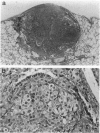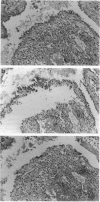Abstract
Sclerosing hemangioma of the lung remains poorly understood, and it is still unclear whether this lesion is neoplastic or not. It consists of two major cell types, pale cells and cuboidal cells. We analyzed the clonality of each cell types from six female cases of surgically resected sclerosing hemangioma. The pale cells and cuboidal cells were separated by microdissection from methanol-fixed sections, and DNA was extracted for clonal analysis based on an X-chromosome-linked polymorphic marker, the human androgen receptor (HUMARA) gene or the phosphoglycerate kinase (PGK) gene. The HUMARA and PGK genes were found to be amplified with or without digestion by the methylation-sensitive restrictive endonuclease HpaII. Five of six cases were informative. Pale cells and cuboidal cells showed the same monoclonality in all of the informative cases, whereas the control cells showed a polyclonal pattern. Our results demonstrated that sclerosing hemangioma is caused by monoclonal expansion of cells, confirming that it is a neoplasia. Moreover, the present data indicate that both pale cells and cuboidal cells are derived from the same cell.
Full text
PDF




Images in this article
Selected References
These references are in PubMed. This may not be the complete list of references from this article.
- Allen R. C., Zoghbi H. Y., Moseley A. B., Rosenblatt H. M., Belmont J. W. Methylation of HpaII and HhaI sites near the polymorphic CAG repeat in the human androgen-receptor gene correlates with X chromosome inactivation. Am J Hum Genet. 1992 Dec;51(6):1229–1239. [PMC free article] [PubMed] [Google Scholar]
- Chan K. W., Gibbs A. R., Lo W. S., Newman G. R. Benign sclerosing pneumocytoma of lung (sclerosing haemangioma). Thorax. 1982 Jun;37(6):404–412. doi: 10.1136/thx.37.6.404. [DOI] [PMC free article] [PubMed] [Google Scholar]
- Fialkow P. J. Clonal origin of human tumors. Biochim Biophys Acta. 1976 Oct 12;458(3):283–321. doi: 10.1016/0304-419x(76)90003-2. [DOI] [PubMed] [Google Scholar]
- Gale R. E., Wheadon H., Boulos P., Linch D. C. Tissue specificity of X-chromosome inactivation patterns. Blood. 1994 May 15;83(10):2899–2905. [PubMed] [Google Scholar]
- Gilliland D. G., Blanchard K. L., Levy J., Perrin S., Bunn H. F. Clonality in myeloproliferative disorders: analysis by means of the polymerase chain reaction. Proc Natl Acad Sci U S A. 1991 Aug 1;88(15):6848–6852. doi: 10.1073/pnas.88.15.6848. [DOI] [PMC free article] [PubMed] [Google Scholar]
- Hill G. S., Eggleston J. C. Electron microscopic study of so-called "pulmonary sclerosing hemangioma". Report of a case suggesting epithelial origin. Cancer. 1972 Oct;30(4):1092–1106. doi: 10.1002/1097-0142(197210)30:4<1092::aid-cncr2820300431>3.0.co;2-k. [DOI] [PubMed] [Google Scholar]
- Katzenstein A. L., Gmelich J. T., Carrington C. B. Sclerosing hemangioma of the lung: a clinicopathologic study of 51 cases. Am J Surg Pathol. 1980 Aug;4(4):343–356. doi: 10.1097/00000478-198008000-00003. [DOI] [PubMed] [Google Scholar]
- Katzenstein A. L., Weise D. L., Fulling K., Battifora H. So-called sclerosing hemangioma of the lung. Evidence for mesothelial origin. Am J Surg Pathol. 1983 Jan;7(1):3–14. doi: 10.1097/00000478-198301000-00001. [DOI] [PubMed] [Google Scholar]
- Kay S., Still W. J., Borochovitz D. Sclerosing hemangioma of the lung: an endothelial or epithelial neoplasm? Hum Pathol. 1977 Jul;8(4):468–474. doi: 10.1016/s0046-8177(77)80012-9. [DOI] [PubMed] [Google Scholar]
- Kennedy A. "Sclerosing haemangioma" of the lung: an alternative view of its development. J Clin Pathol. 1973 Oct;26(10):792–799. doi: 10.1136/jcp.26.10.792. [DOI] [PMC free article] [PubMed] [Google Scholar]
- LIEBOW A. A., HUBBELL D. S. Sclerosing hemangioma (histiocytoma, xanthoma) of the lung. Cancer. 1956 Jan-Feb;9(1):53–75. doi: 10.1002/1097-0142(195601/02)9:1<53::aid-cncr2820090104>3.0.co;2-u. [DOI] [PubMed] [Google Scholar]
- Mutter G. L., Boynton K. A. PCR bias in amplification of androgen receptor alleles, a trinucleotide repeat marker used in clonality studies. Nucleic Acids Res. 1995 Apr 25;23(8):1411–1418. doi: 10.1093/nar/23.8.1411. [DOI] [PMC free article] [PubMed] [Google Scholar]
- Nagata N., Dairaku M., Ishida T., Sueishi K., Tanaka K. Sclerosing hemangioma of the lung. Immunohistochemical characterization of its origin as related to surfactant apoprotein. Cancer. 1985 Jan 1;55(1):116–123. doi: 10.1002/1097-0142(19850101)55:1<116::aid-cncr2820550119>3.0.co;2-4. [DOI] [PubMed] [Google Scholar]
- Ng W. L., Ma L. Is sclerosing hemangioma of lung an alveolar mixed tumour? Pathology. 1983 Apr;15(2):205–211. doi: 10.3109/00313028309084715. [DOI] [PubMed] [Google Scholar]
- Noguchi M., Kodama T., Morinaga S., Shimosato Y., Saito T., Tsuboi E. Multiple sclerosing hemangiomas of the lung. Am J Surg Pathol. 1986 Jun;10(6):429–435. doi: 10.1097/00000478-198606000-00008. [DOI] [PubMed] [Google Scholar]
- Noguchi S., Motomura K., Inaji H., Imaoka S., Koyama H. Clonal analysis of human breast cancer by means of the polymerase chain reaction. Cancer Res. 1992 Dec 1;52(23):6594–6597. [PubMed] [Google Scholar]
- Nomura S., Kaminishi M., Sugiyama K., Oohara T., Esumi H. Clonal analysis of isolated single fundic and pyloric gland of stomach using X-linked polymorphism. Biochem Biophys Res Commun. 1996 Sep 13;226(2):385–390. doi: 10.1006/bbrc.1996.1365. [DOI] [PubMed] [Google Scholar]
- Nowell P. C. The clonal evolution of tumor cell populations. Science. 1976 Oct 1;194(4260):23–28. doi: 10.1126/science.959840. [DOI] [PubMed] [Google Scholar]
- Satoh Y., Tsuchiya E., Weng S. Y., Kitagawa T., Matsubara T., Nakagawa K., Kinoshita I., Sugano H. Pulmonary sclerosing hemangioma of the lung. A type II pneumocytoma by immunohistochemical and immunoelectron microscopic studies. Cancer. 1989 Sep 15;64(6):1310–1317. doi: 10.1002/1097-0142(19890915)64:6<1310::aid-cncr2820640624>3.0.co;2-s. [DOI] [PubMed] [Google Scholar]
- Sidransky D., Frost P., Von Eschenbach A., Oyasu R., Preisinger A. C., Vogelstein B. Clonal origin bladder cancer. N Engl J Med. 1992 Mar 12;326(11):737–740. doi: 10.1056/NEJM199203123261104. [DOI] [PubMed] [Google Scholar]
- Spencer H., Nambu S. Sclerosing haemangiomas of the lung. Histopathology. 1986 May;10(5):477–487. doi: 10.1111/j.1365-2559.1986.tb02499.x. [DOI] [PubMed] [Google Scholar]
- TITUS J. L., HARRISON E. G., CLAGETT O. T., ANDERSON M. W., KNAFF L. J. Xanthomatous and inflammatory pseudotumors of the lung. Cancer. 1962 May-Jun;15:522–538. doi: 10.1002/1097-0142(196205/06)15:3<522::aid-cncr2820150312>3.0.co;2-7. [DOI] [PubMed] [Google Scholar]
- Vogelstein B., Fearon E. R., Hamilton S. R., Feinberg A. P. Use of restriction fragment length polymorphisms to determine the clonal origin of human tumors. Science. 1985 Feb 8;227(4687):642–645. doi: 10.1126/science.2982210. [DOI] [PubMed] [Google Scholar]
- Yousem S. A., Wick M. R., Singh G., Katyal S. L., Manivel J. C., Mills S. E., Legier J. So-called sclerosing hemangiomas of lung. An immunohistochemical study supporting a respiratory epithelial origin. Am J Surg Pathol. 1988 Aug;12(8):582–590. [PubMed] [Google Scholar]





